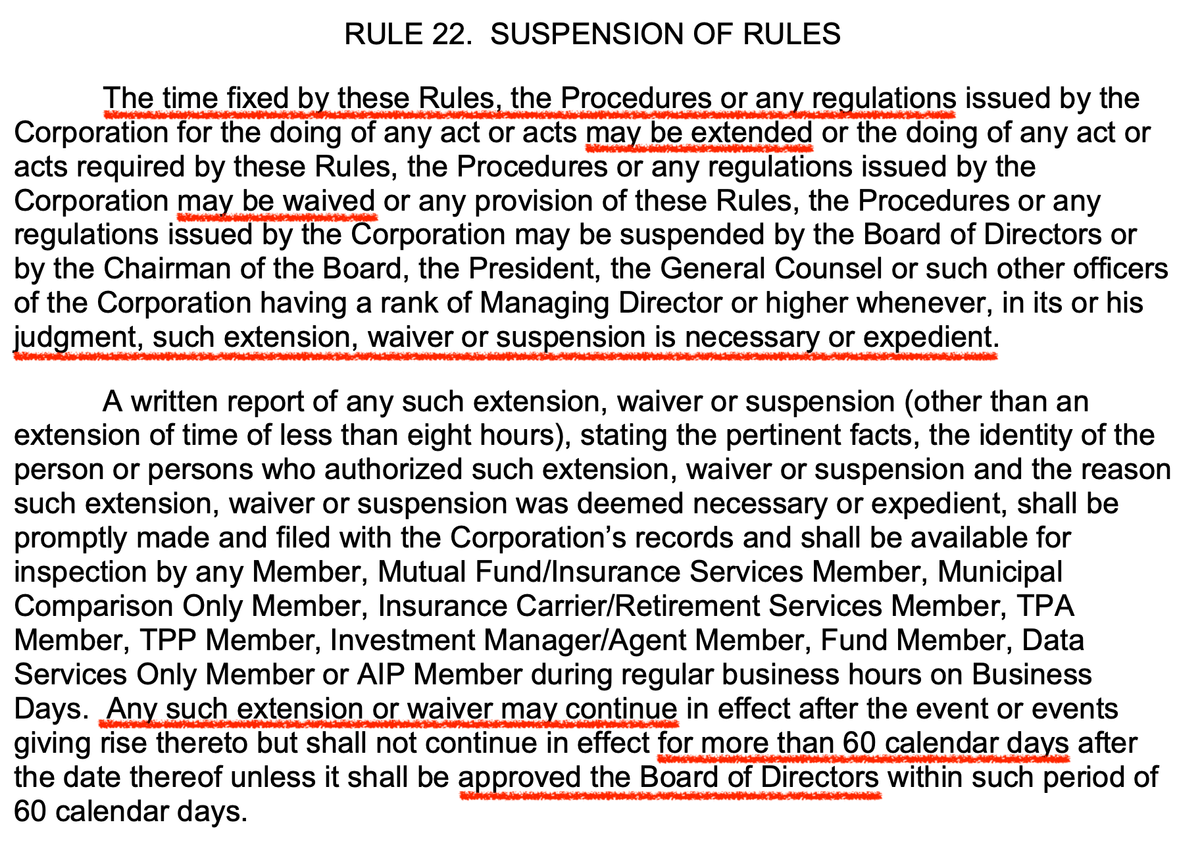SEC Commissioner Hester M. Peirce: "Periodically revisiting the rules to ensure they are working properly is important. For that reason, I am supporting today’s proposal."
SEC Commissioner Hester M. Peirce: "Periodically revisiting the rules to ensure they are working properly is important. For that reason, I am supporting today’s proposal. That support comes with a plea for input from the public despite the as-is-now-usual unduly short comment period."
https://www.sec.gov/news/statement/peirce-statement-clearinghouse-051723
Thank you, Mr. Chair. Moving risk into a clearing agency does not eliminate risk, but doing so can foster market resilience if the clearing agency manages its own risks well. Clearing mandates and non-member-owned clearing agencies complicate risk management make a regulatory hand in risk management inevitable. Regulating clearing agencies is difficult and delicate work. If we get it wrong, the harm to the market could be severe. Periodically revisiting the rules to ensure they are working properly is important. For that reason, I am supporting today’s proposal. That support comes with a plea for input from the public despite the as-is-now-usual unduly short comment period.
Clearing agencies perform an important if often challenging function in our markets. In serving as central counterparties, clearing agencies, for example, help market participants manage counterparty risk by stepping in to become the counterparty to both parties to the trade. You do not have to know your trading counterparty’s identity or its creditworthiness if a clearinghouse is your ultimate counterparty. Clearing agencies also facilitate multilateral netting and sound margin practices. In parts of our financial markets that are served by a single clearing agency, that clearing agency’s continued operation is essential to the market.
Clearing agencies do not achieve these benefits by eliminating risk but by concentrating it in a single entity, the clearing agency itself. Although clearinghouses began as self-regulated, member-owned organizations, market and regulatory changes have resulted in clearing agencies’ being subjected to an increasingly complex web of competing incentives woven with regulatory and market threads.
It is no surprise, then, that financial markets regulators, including the Commission, want to ensure that clearing agencies have in place an effective risk management framework. Whether this state of the world is preferable to one where clearing agencies and their member-owners are largely free to manage their own risks is beyond today’s scope of inquiry. The Commission’s role in overseeing clearing agencies is inescapable, and we need the public’s help in figuring out how to tackle the job.
Requiring that CCPs have the ability to collect margin “as frequently as circumstances warrant” and have in place more robust systems for obtaining timely pricing data may be a reasonable response to the remarkable market events we have seen over the past several years. Posting and collecting margin are important risk management tools, but as we saw during the meme stock event, these tools can have unpredictable effects on market participants and investors. Predictability is important, but a clearing agency’s ability to exercise discretion in collecting margin also can be an important tool in preserving orderly markets. We are not proposing to mandate any particular schedule for the collection of margin, but if the amendment and subsequent rule filing process convey to CCPs that the Commission expects them to collect intraday margin as a matter of course, the end result could be the same. And even if no such expectation is conveyed, CCPs may find it difficult to resist using a tool that the Commission has required them to place in their toolboxes, even if it could have deleterious effects on the CCP participants or on the markets more broadly.[1] I hope that commenters will help us better understand the possible effects of this proposed amendment, including whether it may exacerbate the operational procyclicality of margin requirements for cleared transactions.
Similarly, given the significant risk housed in CCPs, the proposal to impose more specific requirements on covered clearing agencies’ recovery and wind-down plans while preserving an approach that is generally principles-based also seems reasonable. Ensuring that covered clearing agencies are thinking carefully about the key issues that are likely to be relevant in a recovery or wind-down scenario and being transparent about their thinking could yield benefits. It could reduce the risk that a clearing agency will have to be resolved, with all the legal and other uncertainty that entails, avert broader market chaos in the event of significant losses at the clearing agency, and help market participants to gauge realistically their exposure to clearinghouses.[2] The proposed requirement that covered clearing agencies conduct regular testing of the plans—and that they involve participants in that testing—may help clarify responsibilities, potential operational pitfalls, and likely demands on CCP participants that may not otherwise be apparent even from reviewing the most expertly drafted plans on paper.[3] To the extent that these requirements, including testing of the plans and presentation to the clearing agency’s board of directors, encourage more accurate assessments of the costs to the clearing agency and its participants of recovery and a possible wind-down, that knowledge may lead those involved in clearing to take risk management more seriously.
I do, however, have a couple of concerns with this proposed amendment. First, the rule would require that the clearing agency test the plans “at least every 12 months,” and this testing would need to include participants and, “when practicable, other stakeholders.” Although I am inclined to agree that regular testing provides a critical reality check on these plans and likely improves their implementation if they eventually prove necessary, testing these plans at this frequency may impose undue burdens on clearing agencies, participants, and other stakeholders. Second, the proposed amendments are largely principles-based, but the release, in justifying the new requirement, notes that existing recovery and wind-down plans “have, to a great degree, converged in terms of the types of elements that are included in each plan” and suggests that the proposed rule would help ensure that the plans contain all the same elements. Although it may be reasonable to require clearing agencies to ensure that their plans address a common set of issues, I hope that the amendments do not foreshadow a desire to harmonize recovery and wind-down plans through the Commission’s rule filing process. Given the significant differences in the clearing agencies’ products and participants, continuing to permit diversity in the specifics of these plans seems prudent.
I would like to express my thanks to the Division of Trading and Markets and the Division of Economic and Risk Analysis for the time they spent with my office to discuss this proposal. Particular thanks go to Elizabeth Fitzgerald for her hard work on this important project. Thank you also to everyone else throughout the building who worked on this rule making.
Proposed Rule (130 pages):



Press Release: https://www.sec.gov/news/press-release/2023-95
The Securities and Exchange Commission today proposed rule changes that would improve the resilience and recovery and wind-down planning of covered clearing agencies. The proposal would amend the existing rules regarding intraday margin and the use of substantive inputs to a covered clearing agency’s risk-based margin system and add a new rule to establish requirements for the contents of a covered clearing agency’s recovery and wind-down plan.
“Today’s proposal would help ensure the continuity of clearing services during times of significant stress,” said SEC Chair Gary Gensler. “Well-regulated and well-managed clearinghouses help lower risk for the public. I am pleased to support the proposal because, if adopted, it would help enhance the resiliency of this part of our market plumbing, which is fundamental for the capital markets to operate. That benefits investors, issuers, and the markets alike.”
Specifically, the proposal would require that a covered clearing agency have policies and procedures to establish a risk-based margin system that monitors intraday exposure on an ongoing basis and includes the authority and operational capacity to make intraday margin calls as frequently as circumstances warrant, including when risk thresholds specified by the covered clearing agency are breached or when the products cleared or markets served display elevated volatility. The proposal would also require that a covered clearing agency have policies and procedures to establish a risk-based margin system that address the use of substantive inputs to its risk-based margin system, specifically, when such inputs are not readily available or reliable.
The proposal also includes a new rule, which would build upon the existing requirement that a covered clearing agency have a recovery and wind-down plan and specify nine elements that a covered clearing agency would be required to include in its recovery and wind-down plan.
The public comment period will remain open for 60 days following publication of the proposing release on the SEC website or 30 days following publication of the proposing release in the Federal Register, whichever period is longer.



